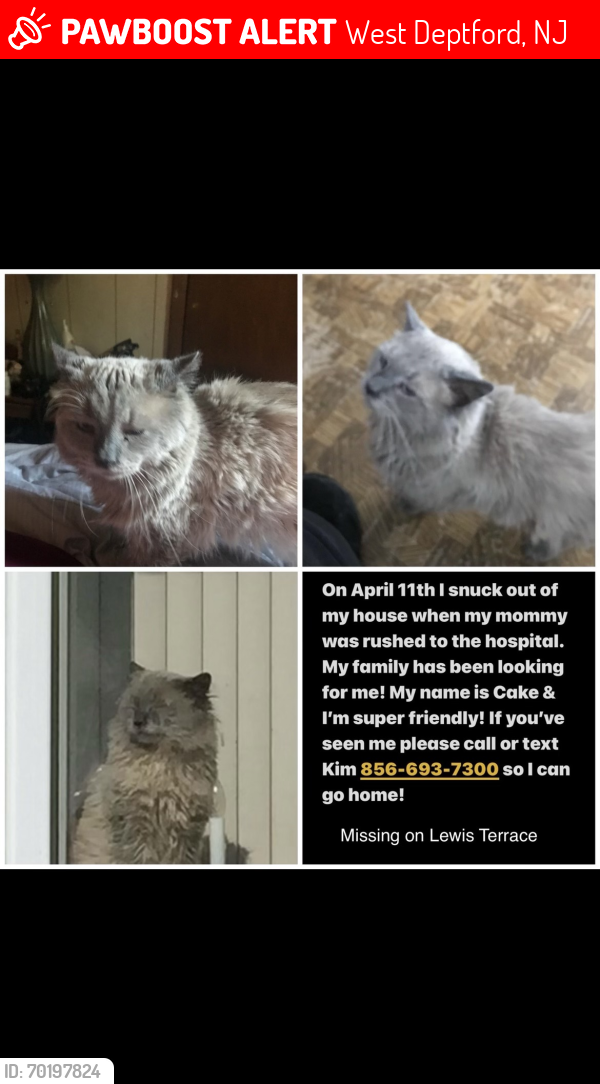PAWBOOST ID
70197824
NAME
Cakie
STATUS
LOST
SEX
Male
SPECIES
Cat
MESSAGE FROM OWNER
We miss him so much! PLEASE HELP!
AREA LAST SEEN
West Deptford, NJ 08066
ADDRESS LAST SEEN
Lewis Terrace and Hessian
DATE LAST SEEN
April 11, 2024

 Contact Owner
Contact Owner
PAWBOOST ID
70197824
NAME
Cakie
STATUS
LOST
SEX
Male
SPECIES
Cat
MESSAGE FROM OWNER
We miss him so much! PLEASE HELP!
AREA LAST SEEN
West Deptford, NJ 08066
ADDRESS LAST SEEN
Lewis Terrace and Hessian
DATE LAST SEEN
April 11, 2024
2 weeks ago
Tips Lost Cats NJ If adopted from rescue or shelter notify them immediately since they may offer help. Cats don’t always come back on their own. Setting a trap and following tips offered is important. Ask local shelter for listing of a rescue with an experienced trapper who may help. If they have no listing look on Petfinder for rescues in your zip code. Avoid all text, Instagram, and "miracle pet finder" scams. Don't ever give up hope, keep searching, and update group! Posters with “Do not chase, call with sighting” are very important and using Pawboost has helped many owners as well. Marie Ganz helped a local rescue find two cats on separate occasions lost for over a month and has helped many other owners. Her contact info is listed below along with other tips. Have neighbors check their Ring videos. Feel free to message me to review if needed. Feel free to copy & paste to share with any owners of lost cats. Here's tips for finding lost cats. If the cat was adopted from a rescue, notify them immediately and ask if they can offer help and suggestions. If no one saw cat leave house, search thoroughly inside using flashlight to see eye reflection and open and check closets, cabinets, drawers, attics and bats - make sure he or she didn't get stuck in ceiling by pushing tiles open, or anywhere else. You can keep closet and other inside doors open and place bowl of food with flour around it to see if it’s been eaten - look for paw prints. Cats hide when not feeling well. FIRST and most importantly, read tips on missinganimalresponse (.com) websites for information on searching based on cat's temperament, behavior, and whether indoor only, indoor/outdoor, or outdoor only. Also use information on sites for neon poster format (always add Do Not Chase - Call with Sighting, Check Sheds, Garages etc. with Flashlight.), resource links, and pet detective services. If your cat is indoor only and spayed/neutered, he or she is probably hiding nearby and staying within 5-10 houses or if further, 5-10 blocks in either direction or less unless chased out of territory. Normally they hide first few days and then venture out at night or early morning for food when quieter. They usually find a specific place to access for shelter like in or under sheds, decks, porches, garages, or by bushes establishing this as a base to leave from looking for food and return ing to. for safety. Inside only cats are usually more scared, hide longer, and stay closer to home. See more tips below. Conduct searches starting at home and expanding in circular radius from starting point to thoroughly check and cover areas. Repeat as necessary. Put supervised only trap and check every 2 hours in good weather and every half hour to hour depending on hot or cold temperatures with food in it in your yard and by last sighting. Keep in mind setting 3 traps spaced out in triangle increases chances. Never leave trap set when no one is there, close trap, remove bait food, and wash trap if another animal was caught. May be better not to leave food overnight to avoid attracting wildlife, etc. or just use dry food if trapping at night. Make sure each trap is covered top and sides, supervised at all times, and checked often. Put 1/2 of dry food feeding and water out daily after 2nd or 3rd day and away from trap to keep in area. Put something that smells like you (worn socks) and cat (toy, bedding, etc.) in yard and smaller item(s) in trap or nearby - add catnip if he or she likes it. Many advise not to put out used litter, as it may attract a predator. Note: Kentucky Fried Chicken (no bones) is a good choice to use for bait food and/or their favorite food. Go with your intuition with what may work best for your cat. Many people use Pawboost it’s a very good alert system and comments on Facebook posts update on pawboost (.com). There are also petamberalert (.com), petfbi (.org), and lostmykitty (.com) for poster and notification services to neighbors, vets, shelters, and rescues in area. Nextdoor app is also good for notifying neighbors. Ask if neighbors have ring or other security cameras that they can check and notify you of any sightings. Put up posters ASAP, and notify non-emergency police and animal control in surrounding areas and bring posters for them to put up on bulletin board. Enlist daily help by giving posters to neighbors, joggers, walkers, dog walkers, public works, mailmen, and older children who are out regularly in area to keep an eye out for your pet. Make sure to speak to and give posters to anyone feeding cats in your neighborhood. Post on local town Facebook pages, and town, county, and state lost and found Facebook pages - Lost Cats, etc. Leave garage, shed, or porch open for cat to access, put their bed and something with your scent and theirs, when possible. In wintertime, put out shelter, igloo with straw etc. Use baby monitor to hear if crying during night, and you can purchase security camera and/or wildlife camera with IR night vision to monitor activity in yard and by feeding station. Newer ones have Apps to view immediately if a photo is taken. Ask neighbors if you can check yards, garages, porches, and in and under sheds and decks - use flashlight. Ask them to check as well. Go at dusk, evening, and before dawn with a good flashlight to see reflecting eyes. Check trees, as well. Do not chase, or call. If sighted lie on ground shake treats to see if your cat will come to you. Most go into feral mode so it is better to set a trap in yard and at last sighting following above instructions. Ask area rescues if they can assist with hanging posters if you need help with this and especially with trapping if they have experienced volunteers. Remember indoor only cats may hide first few days but venture out when hungry coming out of hiding when quiet. DO NOT CHASE! (Put this on all flyers!). If hiding place is found, set supervised only and covered traps with permission in that area. In extreme hot or cold weather trap must be watched when set and checked hourly. Check petfinder (.com) for cats in rescue and shelter, and go to local shelters in person daily. If cat has microchip, call the company to report lost and ensure chip is registered and information is correct. If open to this, you can try animal communicator Marie Ganz who is on Facebook to provide detailed description of area pet is lost and will provide updates when requested if pet is on the move. She has helped reunite multiple owners with their pets. You can consult with Kimberley Freeman if Marie is unavailable and if Kimberley still offers consultations. How to Find a Lost Cat on YouTube Front Street Animal Shelter video on Facebook. Avoid instagram scam referrals. Send a message if you would like to review tips. 🙏🏻
2 weeks ago
📌🐾 📣 Open Escape for Reentry‼️ ⭐️ Keep point of escape open for reentry with a plate of smelly food inside of house. Kitty might try to get back in from either fear, hunger, thirst, weather or comfort. If still nearby, keep looking and listening for meowing. 👉Return: I’m noticing a pattern of return around 3am - 6am. ➡️ Alternative Opening: If you can’t leave an opening in your home for reentry and you have a garage, open the door about 6 inches up with food and water placed in back of room or find some place where cat may shelter and leave food (lamb chop seems to entice) & water there. 👉 Seeking Shelter: During the winter months cats may look for a place to keep warm and they’ll want to seek out shelter from the rain, cold and snow. 📌 If cat is an indoor cat it should hopefully be very near still and hiding in fear. • Search Immediately - Look under bushes, under porches, under decks, especially under sheds, including any small place they can crawl into & corners they can back into, look in-between fences, check car engines, on top of car tires & under cars, look up in the trees and on roof tops, in window wells, nearby sewers, garages, in and behind garages and sheds and neighboring properties. Look in all corners of the above and under items in those places. Most of the time they back themselves into a corner and remain quiet, even to you because they’re scared. Listen for the slightest noise of movement and move items around and use a flashlight looking for glowing eyes. •Search when it’s quiet, early in the morning and when it’s dark with a flashlight for glowing eyes, shaking a bag of treats while calling out their name and then stop and listen for faint meowing. •Try a Cat Meowing App and playing it in hopes it draws out the cat. •Some cats hide at the house directly behind the house cat was missing from. •Use a night vision motion detector video camera with sound that sends notifications to your cell phone. Aim outside at each door, where food is placed and at the humane trap. Ring, Arlo or anything else that records. •Shelter- Place near where cat escaped adding straw (not hay), some catnip inside and spread some on a toy. Throw toy in back of shelter and watch to see if it’s taken out and played with. 👉 Scent- Put used litter box outside. Plenty of people have told me their cats returned shortly after placing the litter box either outside, in garage or another enclosure and I stand by this. •Empty contents of vacuum bag orter your unlaundered items such as socks, pillowcases, something cat laid on, etc. to attract lost cat. •Leave smelly food near where you want them to return. Ex. Tuna, sardines, Mackerel, chicken, lamb or treats. Bbq hot dogs, bacon or chicken sending the aroma throughout the air. •Trackers: Pet Trackers may offer assistance via phone of what to do next and or in-person with a tracking dog. Time is crucial: Cats usually stick closer to home, but could end up over a mile away. •Capture/Trapping- Ask for experienced help on groups that trap, handle strays and TNR. **Important: A live trap must never be left set overnight or unattended ‼️ Opossums and raccoons can easily enter the unattended traps instead of your cat and harm themselves ripping out their teeth and nails. Then after being trapped, they’re released wounded and toothless. -If you choose not to use a trap, place small amounts of cat food & water out and hopefully you’ll eventually be able to determine where the cat is hiding. 👉 More Exposure! •Post on & join all lost groups of Facebook •Post on Neighbors Ring App or on Neighbors Ring website. It alerts the community in radius of up to 5 miles around your home anonymously. •Post on Next Door App or on Next Door website. •Post on Lost My Kitty website (they send out emails about kitty & you remain anonymous). •If microchipped, notify chip company & they’ll send out alerts. •Flyers: Keep it simple! No one needs to know why, how, your pet's habits or about the family. Only Include: photo of pet (cropped with only that pet missing) name of pet date last seen cross streets & town phone number Print at least 100 copies. Cover in plastic. Get helpers & post on trees, poles, at supermarkets, pet supply stores, pharmacies, hang on your car, etc. •Handout flyers to Mail Carriers, Amazon Drivers, Fed Ex Drivers, UPS Drivers, Newspaper Delivery person, Crossing Guards, Veterinary groups, Shelters, Groomers, Police Precinct, Town Highway Division, etc. •Enlarge a flyer, wrap in plastic, post on front lawn so drivers and walkers can see it. •Animal Shelters- Go in person everyday to check and see for yourself because employees may not know of all the pets that were brought in. •There’s many reasons why a cat has gone missing, One of the more common scenarios for a lost outdoor-access cat is that the cat has become displaced from his home range. This may occur if he is new to the area and becomes lost or if he is scared out of his territory (such as by fireworks, construction, a loose dog, or another cat) and either becomes lost or is afraid to come back. Some cats will choose to leave their homes when there is a significant change in the household such as a new baby, puppy or roommate. Some cats are more sensitive than others and may leave due to a change in routine such as a prolonged injury or illness of their owner or even a small change in circumstances such as a remodeled room or change in brand of cat food. Researched & written by Donna Harman
2 weeks ago
Put her favorite human's used shower towel outside. The scent will carry.

JOIN THE
The Rescue Squad™ is a group of 3,270,094 pet lovers who have signed up for local lost & found pet alerts.

Your PawBoost account has been created!
Please check your email for a verification link to complete the sign up process.


